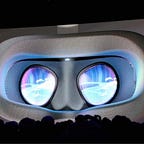Virtual reality for pain relief and Stentrode: A brain computer interface that can be implanted in the brain without open brain surgery.
At the Game Developer Conference in 2019 I spoke to David Putrino, PhD, about Mount Sinai’s work on a Neural Lace product called Stentrode. In his talk titled “Pain Medication Reimagined: VR for Chronic Pain” David Putrino spoke briefly about the work (that I understand is led by Thomas J. Oxley, MD, PhD, a neuroscientist at Mount Sinai.) on Stentrode at Mount Sinai
Article by Micah Blumberg, audio interview link is at the bottom of the page.
“Thomas J. Oxley, MD, PhD, is an instructor and Director of Innovation Strategy for the Department of Neurosurgery at the Mount Sinai Health System. As part of the Cerebrovascular Center, he specializes in vascular neurosurgery and interventional neurology, including the treatments of stroke, brain aneurysms, and vascular malformations.” https://www.mountsinai.org/profiles/thomas-j-oxley
“David F Putrino, PhD, is a physical therapist with a PhD in Neuroscience. He worked as a clinician in Australia, before moving to the United States to study computational neuroscience at Harvard Medical School, MIT and NYU. He has served as a faculty member at Weill-Cornell Medicine and Burke Medical Research Institute.” https://www.mountsinai.org/profiles/david-f-putrino
Stentrode is a neural interface that makes it easier implant electrodes into the brain without open brain surgery.
Must watch: A digital spinal cord that streams your thoughts | Thomas Oxley | TEDxSydney
Stentrode is inserted via a catheter into the jugular vein and maneuvered into the brain via the vasculature. There is no need to drill through the human skull. The sensors are built into a self expanding stent that expands into the wall of the blood vessel in the brain in a way that is designed to maintain bloodflow. In time it’s expected that cells will grow over the sensors and incorporate them into the tissue. The signals would be transported out of the brain, through the vein to a unit implanted in the chest and from there signals from the brain may be sent to a computer.
“Stentrode: Moving with the power of thought”
“Minimally Invasive “Stentrode” Shows Potential as Neural Interface for Brain”
Stentrode records brain activity in a way that is similar to EEG or similar to surgically implanted electrodes, with the advantage that its inside the skull (without open brain surgery)
“Synchron Initiates First-ever Clinical Trial to Evaluate Thought-to-Text™ Brain-Computer Interface Technology in Patients with Severe Paralysis”
“The new study of the Stentrode, which is being further advanced by Synchron, a company spun off for this very task, will involve testing the safety of the device while using the company’s Thought-to-Text technology and the BrainOS software. BrainOS allows patients to control all kinds of assistive devices by simply thinking of them, and the combination of the technologies may give severely disabled people the ability to gain real independence.”
In Putrino’s talk on using VR for treating pain he talked about the work of VS Ramachandran and suggested that VR might be used as a sort of virtual reality mirror box treatment for pain relief.
“Phantom Limb Mirror Box video”
To learn more about using VR for pain relief you can check out David Putrino’s Lab youtube channel
In his talk Putrino says there are two main hypothesis for why VR works for pain relief, one is (I’m paraphrasing) that the brain is being repaired by new associations, the other theory is that the brain is being distracted.
At the moment their lab is trying to figure out why Virtual Reality works, how the research community can make better (more effective at pain relief) VR environments, and how to make the pain relief last longer or be more sustainable long term.
Right now the VR treatment is basically 360 video in a Google Cardboard headset, Google Cardboard was chosen because of it’s cost, patients reportedly have complained about the cost of Google Cardboard.
This journalist doesn’t know anyone who can use Google Cardboard for more than a couple minutes without getting a headache, so it’s fairly surprising to hear that this device is what is being used as an experiment in pain relief treatment by some of the top researchers in the world. Although it’s certainly understandable that patients will have very little money to spare for experimental treatments.
Most folks will have to wait some weeks until GDC releases the talk onto youtube, for now only GDC Vault members can visit the GDC Vault to watch “Pain Medication Reimagined: VR for Chronic Pain” by David Putrino, PhD. Until then you can listen to this audio conversation that I recorded after the talk.
